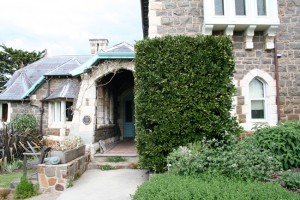
Lemon balm has a delicious sweet lemon flavour.
Tisanes or herb teas have been in vogue in southern Europe since Roman times. The fictional detective Hercule Poirot often needed a tisane after a particularly trying day. Today herb teas are increasing in popularity with the recognition of the harmful effects of too much coffee and ordinary tea. But aren’t herb teas expensive and don’t they taste awful? Not true! Especially if you grow your own, and can experiment with different combinations. Fresh or freshly dried leaves and flowers taste much better than the often musty plant material of questionable content and origin found in shops. Recent research by New York City high school students using simple DNA techniques, found that several herbal teas contain ingredients not listed on the pack. So if you grow and use your own, at least you can be certain about what you are drinking. Read more

Delicious aniseed flavour
French tarragon Artemisia dracunculus is one of the trickiest herbs to grow, but also one of the most rewarding. It’s anise-like flavour is clean, subtle and delightful, while also being penetrating; a little goes a long way. It has smooth narrow bright green leaves on stalks that grow from a spreading roostock. Growing to about 40 cm, it rarely flowers, and never sets viable seed. Read more

The delicate yellow dill flowers attract beneficial insects.
Dill, Anethum graveolens, is a delightful tall annual herb that grows to about 1 m from a taproot, with a single stem and many feathery blue-green leaves and branches. These are topped by groups of umbrella-shaped flower heads made up of small yellow flowers. The flowers are followed by flat, oval, brown seeds, which self-sow readily if left on the plant. Dill is probably one of the oldest medicinal herbs. It was used by the Egyptians before 3000 BC. The name dill is found in several old European languages, reflecting its widespread use, but its derivation is unclear. In medieval times, dill developed a reputation for protecting anyone who carried it against witches. It was a common ingredient in potions and spells and English country brides would wear a sprig of dill on their wedding day, while in Germany, a bride would put dill and salt in her shoes to bring her good luck. By the beginning of the seventeenth century dill was grown in many countries all over the world because it was known as ‘a gallant expeller of wind’. Read more

The white flowers and savory, spicy leaves make this a delightful herb in the garden.
Little known and used winter savory Satureja montana comes into its own in winter. As the days draw in and cold nights become more frequent, its warm spicy fragrance and taste enhances the flavour of slow cooked soups and stews. It grows as a small woody shrub with tiny dark green, opposite leaves and white flowers that grow in the leaf axils towards the ends of the somewhat sprawling branches. There is also a prostrate variety that has coarser leaves, larger white flowers and is much lower growing, but is otherwise similar. Other varieties have pink flowers. It is easily grown from seed or cuttings, or by detaching rooted pieces and replanting. This is best done in spring, but is usually also successful in autumn. Keep the plants neat by trimming back after flowering. Winter savory is in the same family (Lamiaceae) as thyme and rosemary and likes similar growing conditions. In other words a well-drained sandy loam soil and an open, sunny position. But I have found them to be tough little plants that thrive in a variety of positions as long as they do not stay wet for long periods. Read more

A fine leafed form of coriander
Coriander, also known as cilantro and Chinese parsley, is one of the most ancient herbs still in use today. It is also claimed by some to be the world’s most widely used herb. Whether this is true or not, coriander leaves and seeds are essential to the cuisine of central and southern America, South-East and northern Asia as well as India and the Middle East.
History
Coriander comes originally from southern Europe where the seeds have been used for centuries, but the leaves were not usually used. Coriander seeds have been found in Egyptian tombs dating from more than 3000 years ago. The Egyptians cultivated coriander in their gardens and offered it at funeral ceremonies. It was used by Hippocrates and other Greek physicians as early as the fifth century B. C., while the Chinese considered that coriander had the ability to bestow immortality. This plant has the distinction of being one of the few herbs mentioned in the Old Testament Num. 11:7
“Now the manna was like coriander seed.”
The botanical and common name, coriander, comes from the Greek word koris which means ‘bug’. This presumably relates to the fact that the smell and flavour of coriander has been unfavourably compared with that of stink bugs. Read more

Bay trees make wonderful slow-growing hedges or clipped specimen plants. Heronswood, Dromana
Sweet bay (Laurus nobilis ) was seen by the old herbalists as a virtuous tree which “resisteth witchcraft very potently”. The Greeks dedicated it to Apollo, the sun god. The Delphic priestesses, oracles of Apollo, held bay leaves between their lips as they made prophesies. In Greek and Roman cultures victors, heroes, academics and artistic figures were rewarded with a wreath or crown of bay leaves. This gave rise to the terms ‘baccalaureate’ and ‘poet laureate’. Read more






